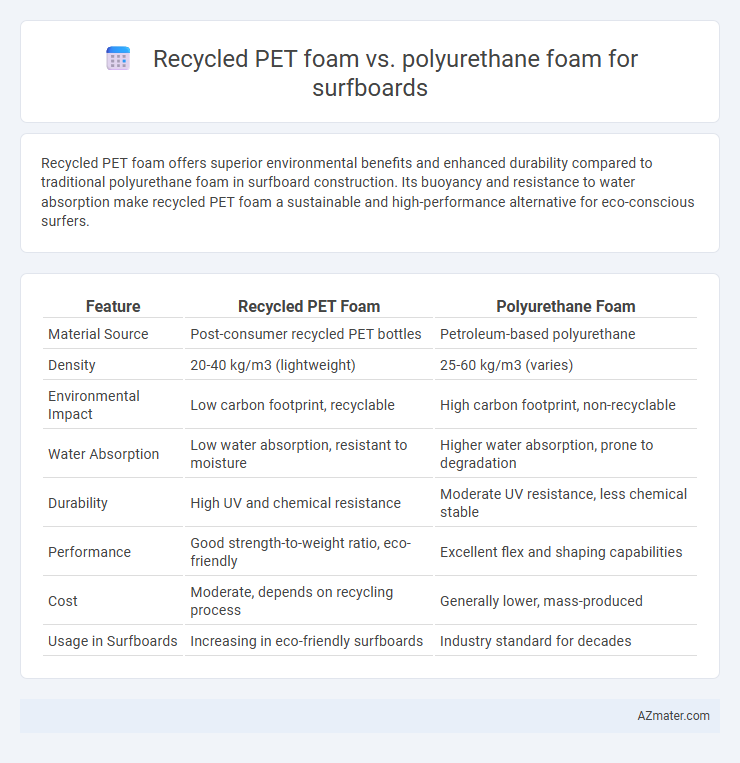Recycled PET foam offers superior environmental benefits and enhanced durability compared to traditional polyurethane foam in surfboard construction. Its buoyancy and resistance to water absorption make recycled PET foam a sustainable and high-performance alternative for eco-conscious surfers.
Table of Comparison
| Feature | Recycled PET Foam | Polyurethane Foam |
|---|---|---|
| Material Source | Post-consumer recycled PET bottles | Petroleum-based polyurethane |
| Density | 20-40 kg/m3 (lightweight) | 25-60 kg/m3 (varies) |
| Environmental Impact | Low carbon footprint, recyclable | High carbon footprint, non-recyclable |
| Water Absorption | Low water absorption, resistant to moisture | Higher water absorption, prone to degradation |
| Durability | High UV and chemical resistance | Moderate UV resistance, less chemical stable |
| Performance | Good strength-to-weight ratio, eco-friendly | Excellent flex and shaping capabilities |
| Cost | Moderate, depends on recycling process | Generally lower, mass-produced |
| Usage in Surfboards | Increasing in eco-friendly surfboards | Industry standard for decades |
Introduction to Surfboard Core Materials
Recycled PET foam and polyurethane foam are two popular surfboard core materials distinguished by their environmental impact and performance characteristics. Recycled PET foam, derived from post-consumer plastic bottles, offers a sustainable alternative with excellent buoyancy, durability, and resistance to water absorption. Polyurethane foam, traditionally used in surfboards, provides a lightweight and flexible core that delivers superior responsiveness and shaping capabilities but poses greater environmental concerns due to its petrochemical origins and slower decomposition rate.
What is Recycled PET Foam?
Recycled PET foam is an eco-friendly surfboard core material made from post-consumer polyethylene terephthalate (PET) plastic, such as used beverage bottles, which undergoes a process of shredding, melting, and reforming into a lightweight, durable foam. This foam offers enhanced sustainability by reducing plastic waste in oceans and landfills while providing a stiff and resilient structure comparable to conventional polyurethane foam. Recycled PET foam also exhibits superior resistance to water absorption and UV damage, extending the lifespan of surfboards in marine environments.
What is Polyurethane Foam?
Polyurethane foam, a widely used material in surfboard manufacturing, is a petroleum-based polymer known for its lightweight, strong, and shock-absorbing properties. Unlike recycled PET foam, polyurethane foam offers superior flexibility and durability, which enhances board performance and rider control. Its closed-cell structure provides excellent water resistance, making it ideal for extended use in marine environments.
Sustainability Comparison: PET Foam vs PU Foam
Recycled PET foam offers significant sustainability advantages over polyurethane (PU) foam in surfboard production due to its use of post-consumer plastic bottles, reducing landfill waste and lowering carbon emissions. PET foam is inherently more recyclable and biodegradable compared to PU foam, which is petroleum-based and harder to recycle, contributing to environmental pollution. The energy consumption in manufacturing recycled PET foam is generally lower, making it a more eco-friendly choice for sustainable surfboard construction.
Performance & Durability: Which Foam Excels?
Recycled PET foam offers enhanced environmental benefits with comparable rigidity and impact resistance to traditional polyurethane foam, making it a strong contender in surfboard performance. Polyurethane foam typically delivers greater buoyancy and superior flexibility, providing surfers with improved control and smooth maneuverability in various wave conditions. Durability-wise, recycled PET foam resists water absorption and salt damage better than polyurethane, extending the surfboard's lifespan in harsh marine environments.
Weight and Flex Characteristics
Recycled PET foam offers a lighter alternative to traditional polyurethane foam, enhancing maneuverability and reducing fatigue during extended surfing sessions. Its flex characteristics provide a balanced combination of stiffness and resilience, promoting improved board responsiveness and durability. Polyurethane foam, while slightly heavier, typically delivers a more consistent flex pattern favored for precise control in various wave conditions.
Shaping and Manufacturing Differences
Recycled PET foam for surfboards offers lightweight and environmentally friendly shaping, utilizing CNC milling or hot wire cutting techniques similar to traditional polyurethane foam but with greater material density variations affecting finishing precision. Polyurethane foam, known for its uniform cellular structure, allows easier shaping and smoother sanding, leading to more consistent resin absorption and lamination quality during manufacturing. Manufacturing with recycled PET foam demands adjusted resin systems and curing times to accommodate its unique thermal properties and resilience, contrasting with the faster processing and established workflows typical of polyurethane foam production.
Environmental Impact & End-of-Life Considerations
Recycled PET foam surfboards significantly reduce environmental impact by repurposing post-consumer plastic waste, lowering carbon emissions and reliance on fossil fuels compared to traditional polyurethane foam, which is derived from petrochemicals and generates toxic byproducts during production. At end-of-life, recycled PET foam offers better recyclability and potential for closed-loop reuse, while polyurethane foam often ends up in landfills due to its non-biodegradable nature and difficulty in recycling. Choosing recycled PET foam supports a circular economy, minimizing ocean pollution and promoting sustainable surfboard manufacturing practices.
Cost and Availability in the Surf Industry
Recycled PET foam for surfboards offers a cost-effective alternative compared to traditional polyurethane foam, benefiting from lower raw material expenses and increasing demand for sustainable products in the surf industry. Polyurethane foam remains widely available with established manufacturing processes, but its price is subject to fluctuations in petroleum markets and environmental regulations. Availability of recycled PET foam is growing as more suppliers adopt eco-friendly materials, though it is still less prevalent than polyurethane in mainstream surfboard production.
Choosing the Right Foam for Your Surfboard
Recycled PET foam offers an eco-friendly alternative to traditional polyurethane foam, providing excellent durability and buoyancy for surfboard construction while reducing environmental impact. Polyurethane foam remains popular for its lightweight properties and easy shaping qualities, allowing precise customization to enhance performance. Selecting the right foam depends on prioritizing sustainability with recycled PET or opting for the proven versatility and weight advantages of polyurethane.

Infographic: Recycled PET foam vs Polyurethane foam for Surfboard
 azmater.com
azmater.com